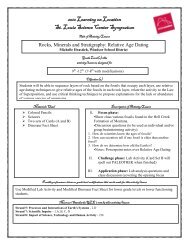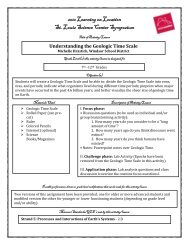Create successful ePaper yourself
Turn your PDF publications into a flip-book with our unique Google optimized e-Paper software.
Worksheet #3<br />
Name:<br />
PROTECTING the Oceans<br />
Grade:<br />
The rising level of carbon dioxide in the atmosphere is one of the<br />
biggest threats to the world’s oceans. Millions of tons of carbon<br />
dioxide are released into the atmosphere every year from burning<br />
fossil fuels, such as oil and gas. Carbon dioxide causes the<br />
atmosphere to warm—a process called global warming. This<br />
heats the world’s oceans. Many sea organisms can’t adapt to the<br />
changing temperatures and may die out.<br />
Carbon dioxide also dissolves into the oceans, causing the water to become acidic. The acidic water<br />
dissolves the shells many ocean creatures rely on to survive.<br />
Complete the questions in the two charts below to become aware of how some activities—involving<br />
transportation and electricity—contribute to the world’s level of carbon dioxide. Then answer the<br />
questions that follow to come up with some ways that you can help to reduce these levels.<br />
Data sources: Transportation figures: GHG Protocol Initiative. Electricity figures: U.S. Department of Energy (average for the United States).<br />
© 2008 Warner Bros. Ent. All Rights Reserved.<br />
Transportation Every time you take a car ride, the car releases carbon dioxide by burning<br />
gasoline. Use the chart below to see how much carbon dioxide is released when you ride in a car.<br />
1. Estimate the number of miles you ride in a car per month:<br />
2. Determine how much gasoline is used for the number of miles you ride in a month. Divide your total monthly miles by<br />
gas mileage. For a small- to medium-size car, divide your monthly total by 28 miles per gallon. For a large car, divide<br />
your monthly total by 21 miles per gallon. Write your answer below:<br />
3. Multiply the number of gallons of gas used by 19.5 to estimate the number of pounds of carbon dioxide released per<br />
month:<br />
What are some ways you could reduce the amount of carbon dioxide you release using transportation?<br />
Electricity Every time you turn on a light or the television, fossil fuels are burned to create<br />
electricity. Use the chart below to see how much carbon dioxide is released when you use electricity.<br />
1. Determine your total household use by studying your family’s energy bill. Look at your electricity bill to see how<br />
many kilowatt-hours of electricity you use in one month:<br />
2. Calculate the number of pounds of carbon dioxide released by multiplying the kilowatt-hours used by 1.34:<br />
What are some ways you and your family could reduce the amount of carbon dioxide you release each<br />
month from your electricity use?<br />
BONUS<br />
ACTIVITY<br />
Under the Sea<br />
Under the Sea highlights some of the effects of carbon dioxide on the oceans. Create a poster<br />
that explains how daily activities such as driving a car and using electricity can affect ocean life.<br />
Include tips on how people can reduce their carbon dioxide contribution.













